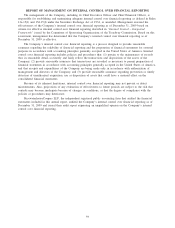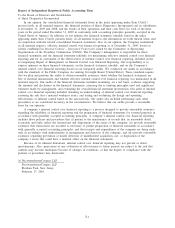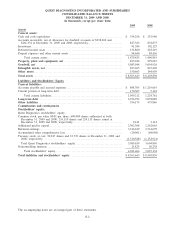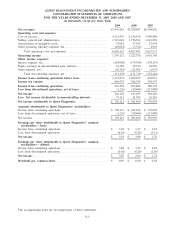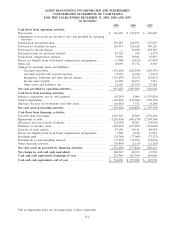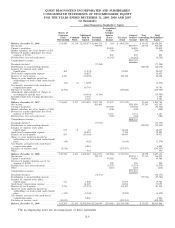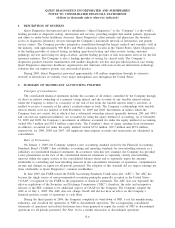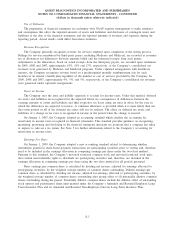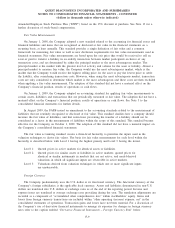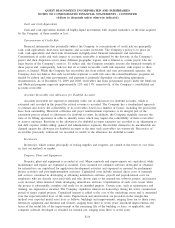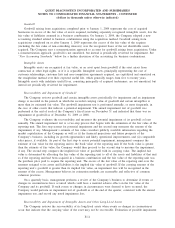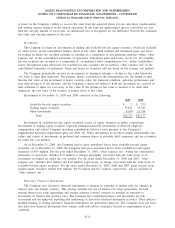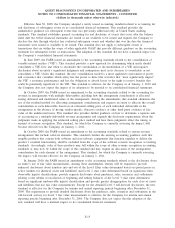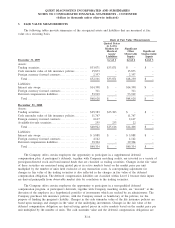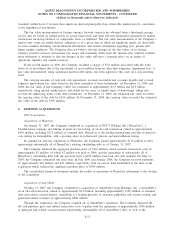Quest Diagnostics 2009 Annual Report Download - page 77
Download and view the complete annual report
Please find page 77 of the 2009 Quest Diagnostics annual report below. You can navigate through the pages in the report by either clicking on the pages listed below, or by using the keyword search tool below to find specific information within the annual report.Use of Estimates
The preparation of financial statements in conformity with GAAP requires management to make estimates
and assumptions that affect the reported amounts of assets and liabilities and disclosure of contingent assets and
liabilities at the date of the financial statements and the reported amounts of revenues and expenses during the
reporting period. Actual results could differ from those estimates.
Revenue Recognition
The Company primarily recognizes revenue for services rendered upon completion of the testing process.
Billings for services reimbursed by third-party payers, including Medicare and Medicaid, are recorded as revenues
net of allowances for differences between amounts billed and the estimated receipts from such payers.
Adjustments to the allowances, based on actual receipts from the third-party payers, are recorded upon settlement.
In 2009, 2008 and 2007, approximately 18%, 18% and 17%, respectively, of the Company’s consolidated net
revenues were generated by Medicare and Medicaid programs. Under capitated arrangements with healthcare
insurers, the Company recognizes revenue based on a predetermined monthly reimbursement rate for each
member of an insurer’s health plan regardless of the number or cost of services provided by the Company. In
2009, 2008 and 2007, approximately 4%, 5%, and 5%, respectively, of the Company’s consolidated net revenues
were generated under capitated arrangements.
Taxes on Income
The Company uses the asset and liability approach to account for income taxes. Under this method, deferred
tax assets and liabilities are recognized for the expected future tax consequences of differences between the
carrying amounts of assets and liabilities and their respective tax bases using tax rates in effect for the year in
which the differences are expected to reverse. A valuation allowance is provided when it is more likely than not
that some portion or all of the deferred tax assets will not be realized. The effect on deferred tax assets and
liabilities of a change in tax rates is recognized in income in the period when the change is enacted.
On January 1, 2007, the Company adopted an accounting standard which clarifies the accounting for
uncertainty in income taxes recognized in financial statements. This standard provides guidance on recognizing,
measuring, presenting and disclosing in the financial statements uncertain tax positions that a company has taken
or expects to take on a tax return. See Note 5 for further information related to the Company’s accounting for
uncertainty in income taxes.
Earnings Per Share
On January 1, 2009, the Company adopted a new accounting standard related to determining whether
instruments granted in share-based payment transactions are participating securities prior to vesting and, therefore,
need to be included in the earnings allocation in computing earnings per share under the two-class method.
Pursuant to this standard, the Company’s unvested restricted common stock and unvested restricted stock units
that contain non-forfeitable rights to dividends are participating securities and, therefore, are included in the
earnings allocation in computing earnings per share using the two-class method for all periods presented.
Basic earnings per common share is calculated by dividing net income, adjusted for earnings allocated to
participating securities, by the weighted average number of common shares outstanding. Diluted earnings per
common share is calculated by dividing net income, adjusted for earnings allocated to participating securities, by
the weighted average number of common shares outstanding after giving effect to all potentially dilutive common
shares outstanding during the period. Potentially dilutive common shares include the dilutive effect of outstanding
stock options and performance share units granted under the Company’s Amended and Restated Employee Long-
Term Incentive Plan and its Amended and Restated Non-Employee Director Long-Term Incentive Plan.
F-7
QUEST DIAGNOSTICS INCORPORATED AND SUBSIDIARIES
NOTES TO CONSOLIDATED FINANCIAL STATEMENTS - CONTINUED
(dollars in thousands unless otherwise indicated)




